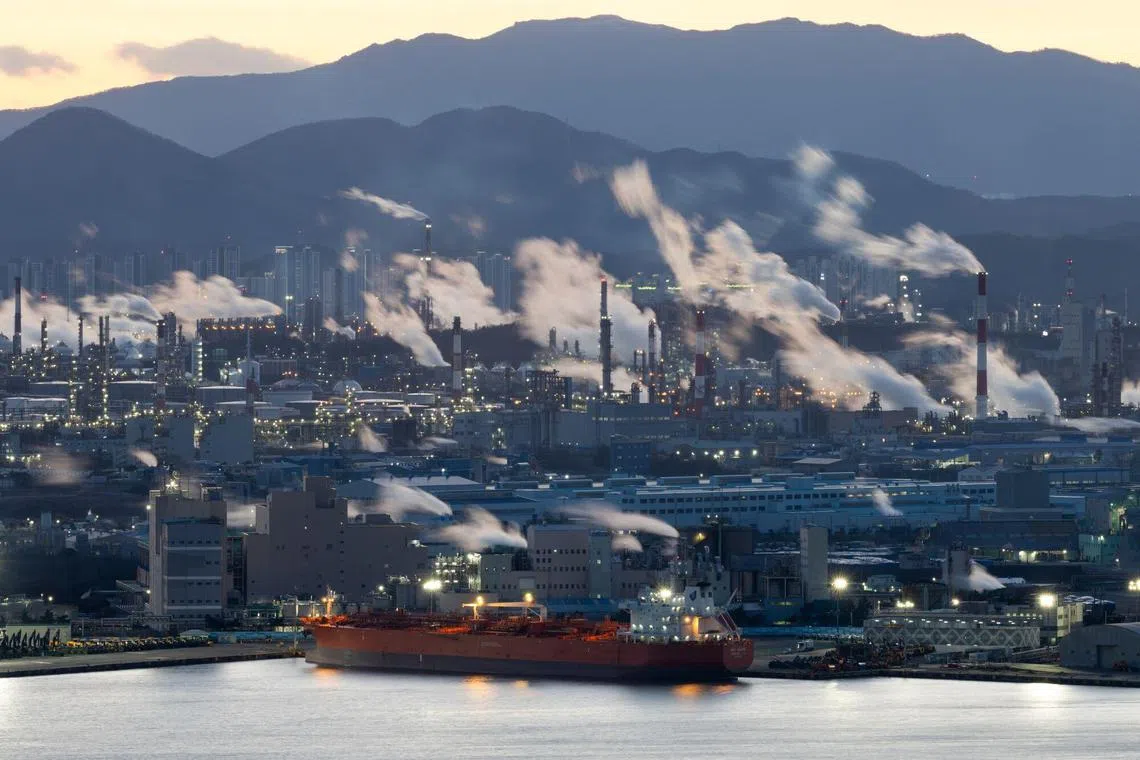Climate litigation a ‘trillion-dollar’ risk for big polluters: Study
Sign up now: Get ST's newsletters delivered to your inbox

Water vapour and smoke rising from an industrial complex at sunset in Ulsan, South Korea, on Jan 23.
PHOTO: BLOOMBERG
Follow topic:
SINGAPORE - Polluting companies could be liable for trillions of dollars in damages from climate lawsuits, said researchers in a recently published study.
They added that many investors and regulators are not taking the growing risk of climate litigation fully into account at a time when companies’ climate-related financial risks are growing.
Climate-related financial risks are typically measured by physical risks and transition risks.
Physical risks focus on areas such as the impacts of worsening climate – for example, storms, floods or wildfires – on company supply chains and infrastructure such as factories.
Transition risks are also closely examined by investors and regulators. These include policies that set emissions reduction targets or a price on carbon emissions, or that of costly older polluting assets made redundant by cleaner energy technology that is cheaper and more efficient.
The study, published on Jan 12, was led by the Oxford Sustainable Law Programme at the University of Oxford.
“If you’re a proactive investor or regulator, you need to be thinking about this now,” said study co-author Arjuna Dibley, head of the University of Melbourne’s Sustainable Finance Hub.
Nearly 2,500 climate lawsuits have been filed globally in various countries and their growing impact presents significant risks for some of the world’s biggest carbon emitters, the study said. A number of cases look at the link between a polluter’s historic emissions and costly climate impacts.
“The basic logic is that because greenhouse gas emissions are cumulative in the atmosphere, firms (with) a long history of emitting large amounts of these emissions face the largest potential liability,” Dr Arjuna told The Straits Times. “There have not been cases yet that have landed on exactly that point, but they will come and there are lots of test cases at the moment in train.”
Successful litigation would redirect costs incurred because of climate change, including adaptation measures, to greenhouse gas emitters, the study said.
In one of the most prominent cases, Peruvian farmer Luciano Lliuya is suing Germany’s largest electricity producer RWE, which is said to be responsible for about 0.5 per cent of the world’s industrial greenhouse gas emissions.
He is deeply worried that glacial melting above his town of Huaraz in Peru
The suit, supported by non-governmental group Germanwatch, alleges that RWE, having knowingly contributed to climate change by emitting substantial volumes of greenhouse gases for many years, bore some measure of responsibility for the melting of mountain glaciers near Huaraz and the swelling of Lake Palcacocha.
Mr Lliuya is seeking a small amount of compensation from RWE to help fund a new dam and drainage system to reduce the risks to the lake, and an acknowledgement of responsibility that RWE’s emissions have contributed to the warming that is speeding up the glacial melting.
Two German judges visited the swollen lake in 2022 to hold their own probes amid the ongoing case.
Two other closely watched cases will be heard by the International Court of Justice (ICJ) and the International Tribunal of the Law of the Sea (Itlos).
The United Nations General Assembly in 2023 asked the ICJ to provide an advisory opinion. In particular, the court has been asked to consider the obligations of states under international law to ensure the protection of the climate system from mankind’s emissions of greenhouse gases for present and future generations.
Itlos has been requested to provide an advisory opinion on states’ obligations under the UN Convention on the Law of the Sea to address marine pollution resulting from climate change. This includes adverse effects such as ocean warming and sea-level rise.
Advisory opinions from these bodies could directly influence domestic laws and policies effected by states, said Ms Elizabeth Wu, international economic lawyer with the Asia-Pacific Centre for Environmental Law at the National University of Singapore.
This in turn could lead to changes in laws that affect firms’ legal obligations. This has implications for Singapore.
“Due to the lack of clarity as legal rules evolve internationally and domestically, the corporate sector in Singapore should be cognisant that present assessments of climate litigation and regulatory risk may be inadequate,” she said.
“Legal rules on attribution, causation, transboundary pollution and the manner in which climate science is treated as evidence further inform assessments of firms’ potential liability and quantum of damages,” she added.
Singapore’s legal community is well-placed to provide greater clarity and guidance on the risks to companies, “particularly as appropriate for Asia”, she said.
The researchers set out a number of ways climate-related legal risks could be better assessed by investors and regulators.
One of these is a market-based analysis. This looks at past successful climate lawsuits to see whether they have had any impact on the share price of a company, for instance. “That then could be a proxy for how litigation in particular could affect companies going forward,” said Dr Dibley.
Another is attribution of climate change damages. Attribution science is a rapidly evolving area. This quantifies how climate change influences the intensity and likelihood of a particular extreme-weather event. Climate cases have already started hearing evidence from scientists in this area, and as climate impacts worsen and attribution science keeps advancing, it is likely to become a powerful tool in court against big polluters.
Climate litigation risk analysis has to calculate the social cost of carbon – which is an estimate of the cost, in dollars, of the damage done to lives and livelihoods by each extra tonne of carbon emissions. Different jurisdictions use different estimates and they can exceed US$100 (S$134) a tonne.
That makes the social impact of emissions “very substantial” for a big historical emitter like a major fossil fuel firm, Dr Dibley said.
It also leaves big polluters vulnerable to litigation risks from climate-vulnerable nations, such as low-lying Pacific islands, which want to hold fossil fuel giants accountable for worsening damage from storms and sea level rise and to pay for the losses and adaptation costs.


